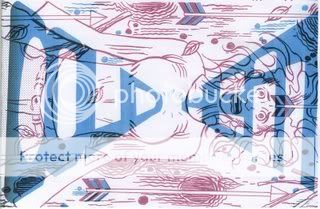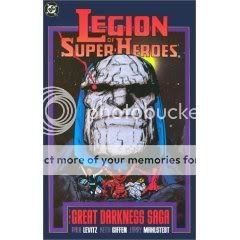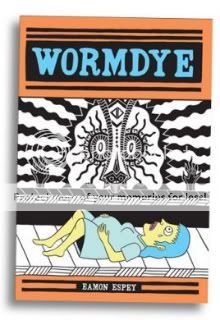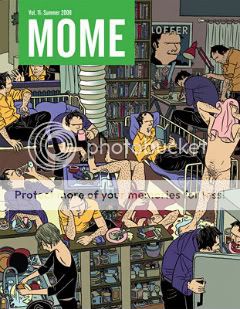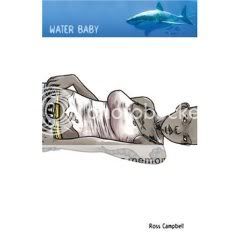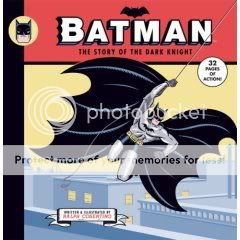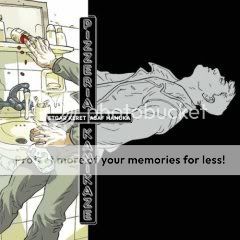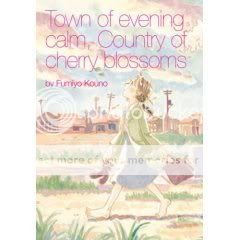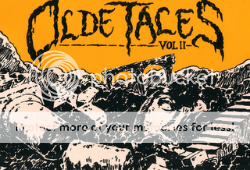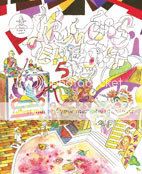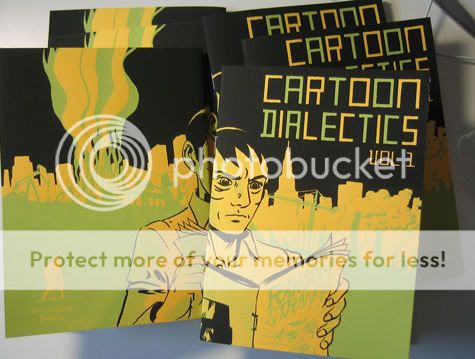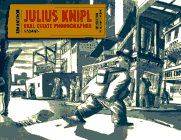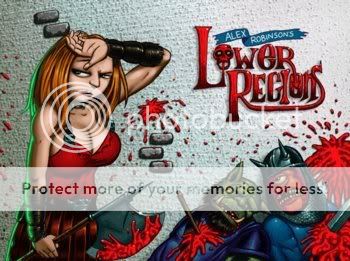Posts Tagged ‘comics reviews’
Comics Time: Cold Heat Special #5
July 28, 2008Cold Heat Special #5
Frank Santoro and Ryan Cecil Smith, writers/artists
PictureBox Inc., 2008
20 pages
$8
As if in response to my questioning if there’s steak beneath Cold Heat‘s sizzle, along comes CHS #5, which reads like Cormac McCarthy’s The Road as filtered through Dave Kiersh’s after-school special aesthetic. Set after some unspecified “bomb” has made refugees of regular CH heroine Castle and her aging father, it concerns Castle’s search for food for her starving dad, and how far she and others are willing to go for it. The centerpiece sequences are harrowing depictions of the killing and attempted killing of dogs for sustenance; the horror and heartbreak of gaining an animal’s trust for the express purpose of betraying it, the core of all human carnivorousness, is laid bare in unflinching detail. As always when I come across depictions of animal cruelty in altcomix I have to wonder if the point is shock value or a genuine consideration of the issues at stake, but the mournful tone Smith lends to his figurework coupled with the comparatively simple and straightforward layouts provided by Santoro give me the sense that we may well be dealing with the latter rather than the former here. That’s kind of a hefty price point, though, so make sure you’re up for it.
Comics Time: Cold Heat Special #3
July 25, 2008Cold Heat Special #3
Frank Santoro & Dash Shaw, writers/artists
PictureBox Inc., 2008
16 pages
$3
I was an enthusiastic early supporter of Cold Heat–you may know me as the guy who wrote about it for Wizard, which is certainly how its creators know me. Perhaps it’s the associations raised by that experience that make me think there’s something fitting about co-creator Frank Santoro spinning off a Cold Heat-verse, complete with guest artists, kinda like what Mike Mignola is doing with Hellboy and the B.P.R.D. This particular one-shot guest stars rising star Dash Shaw, who seems to do handsomer work every time I look at a new thing from him. In this case, though, he surely owes a lot to the layouts provided by Frank Santoro, who makes excellent use of the pages’ landscape format by providing plenty of images that lend themselves to that type of framing–protagonist Castle sneering out a bus window at a cop passing by on horseback in the foreground, a cavalry of knights galloping through a forest or charging directly at the reader, Dark Knight Returns-style. For his part, Shaw draws faces like no one else in comics (as usual), effectively conveys the cacophony of mass-transit public address systems, and crafts an striking fold-out cover.
Until we see the conclusion of Cold Heat it’s difficult to tell whether this alt-genre romp will amount to more than the sum of its parts or less, and I could see that being a point in the minus column for potential buyers of such books as these, but for now I’m enjoying the ride.
Comics Time: Core of Caligula
July 23, 2008Core of Caligula
C.F., writer/artist
PictureBox Inc., June 2008
8 pages
$2
I gather this short but effective minicomic is compiled from even shorter minis, each of which contained one two-page chapter. Removed from their usual overt sci-fi/fantasy setting, C.F.’s slight line and dreamlike narrative can here be seen as either a straightforward story of a man adrift amid forces that seek to monitor, control, and disorient him, or the delusions of a mentally ill man who believes this to be true. It’s funny how simply removing the fancy costumes and creatures from a C.F. comic yields this subtle and troubling a (potential) depiction of schizophrenia, yet there you have it. The protagonist’s zoned-out facial expression, the graphic nudity, the temporal lacunae all yield the sense that there’s something a little terrible about what’s going on even though there’s nothing overtly so. I may like this better than Powr Mastrs, though it’s easy to see why even if blown up into that project’s size and scope it might not garner the same level of attention and acclaim.
Postscript: I’m going to choose to believe that the main character getting thrown from a helicopter naked and surviving is an Ultimates homage.
Comics Time: Ganges #2
July 21, 2008Ganges #2
Kevin Huizenga, writer/artist
Fantagraphics/Coconino, 2008
32 pages
$7.95
I seem to remember not being as impressed by Ganges #1 as everyone else was. Mostly this was because I really, really, really loved Huizenga’s other ongoing (?) series Or Else, and thought the best material there set a standard for depicting transcendent moments in everyday life that this new stuff, keenly observed and gutsily drawn though it was, failed to live up to. No such quibbles about Ganges #2. Huizenga makes it look easy in this tale of dot-com-boom-era follies. Along with “Jeepers Jacobs” it’s one of his most straightforward stories, yet it still employs the techniques of elision and conflation that make his more abstract stuff so powerful.
It actually does start out abstract, with a pair of dueling creatures (boasting almost Marc Bell-ish designs) expanding and colliding in baroquely geometrical ways. No sooner do you realize that their conflict is working almost like a video game would, complete with life meters at the bottom of each image, than you discover it is a video game being played by Huizenga’s everyman Glenn Ganges. This sets him off in a reverie about his old job at an overcapitalized dot-com start-up, one where his actual job consists almost solely of utterly meaningless business jargon and a set of company goals so nebulous as to be nonexistent, but where his co-workers’ marathon after-hours first person shooter sessions provide both their most genuine and heartfelt human interaction and, as the company’s spirit heads south with its finances, becomes almost a point of pride.
Kind of like those rare movie comedies that are actually shot well in addition to being funny–your Annie Halls and your Big Lebowskis–what you’re getting here is something that didn’t need to be as beautifully done as it ended up. So while you’re enjoying the astute Office Space-style corporate-culture takedown, you’re also noticing Huizenga’s choice to only ever show Glenn’s wife Wendy, who was largely ignored by Glenn during his time with the company, facing away from us. Or you’re seeing how Glenn and his white-collar information-industries coworkers’ subtle idealization and thus dehumanization of the company’s long-time pink-collar secretary, Fritz, is conveyed simply by giving her the broadest caricature in the book. Or you’re realizing the extra effort Huizenga put into really capturing the appeal of the video games Glenn plays–the beauty and specificity of the environments in the ostensibly stupid shoot-’em-up, say (one is a perpetual winter morning in a mountain monastery), or the crazy dream logic of the all-ages video game he used to be into, which is described in this brilliantly dead-on passage:
He had always preferred games like, say “Yipper Yap World,” controlling science adventurer Grandma Lagrand as she gathers Fruitclumpz in Death Forest (you need the monkey rocket suit), avoiding the roller skating spiders (by double rocket jumping) in order to throw the fruit at a giant caterpillar who had spun a coccoon in the only satellite dish on the Island of Special Thanks, which had messed up cable TV for the native tribe of Rasta-Ostriches, in exchange for which they give you the moon salsa you need to bribe the Volcano Witch Triplets.”
Maybe Huizenga overwrites the ending, where Glenn and his coworkers all assign their in-game avatars the handle of a fired colleague. I’m trying to figure out if there’s a way to have shown that without explaining it. Maybe there’s not. Maybe it’s better with the captions to explain it and thus take the air out of the moment a bit, lest it get too grandiose. However transcendent that moment might have been for the players, there were still pink slips with each of their names on them waiting in the wings. They could be heroes, but just for one game.
Comics Time: Legion of Super-Heroes: The Great Darkness Saga
July 18, 2008Legion of Super-Heroes: The Great Darkness Saga
Paul Levitz, writer
Keith Giffen, Larry Mahlstedt, Richard Bruning, artists
DC Comics, 1991
192 pages
$17.95
Buy it used for an exorbitant amount via Amazon.com
I don’t know how much you’d get out of this book if you weren’t already a superhero comics devotee. It doesn’t have the revisionist sophistication of Alan Moore or Frank Miller, the high-level craft of the modern-day big-name creators whose work you see praised on blogs like this, the easily recognizable wild imagination of Lee/Kirby/Ditko or even Claremont/Byrne. But for someone like me, who can derive pleasure from variations on familiar themes, this was an engaging read and, I’m betting, a pretty important touchstone for today’s superhero mainstream.
Though the cover gives the game away, what’s interesting about this story is that while it relies on the now-traditional–indeed, almost de rigeur these days–“mystery villain” device whereby our heroes are plagued by sinister, shadowy forces whose true nature and intent are learned only after extensive confrontations with his minions and much fretting and wild-goose-chasing by the heroes (and, just as importantly, the readers), this mystery villain doesn’t just lurk in the background, popping up in a panel or two every other issue to remind us that he exists before he finally reveals himself. Instead, he’s the good guys’ main antagonist throughout–his presence is constantly touted by his minions, he directly addressing both them and our heroes, he even physically confronts them from time to time, all while his identity remains hidden from heroes and readers alike. This strikes me as a far more daring narrative strategy than that used in such ’00s-era arcs as Kevin Smith’s Daredevil: Guardian Devil, Jeph Loeb’s Batman: Hush, Grant Morrison’s New X-Men, Brad Meltzer’s Justice League of America and so on: It practically dares the reader to figure it out, get tired of it, or call bullshit, hoping that if it calls their bluff and they stay involved, they’ll be even more excited by the eventual reveal than if it was just a tease here and there. (In terms of current comics it seems like Morrison’s ongoing Black Glove storyline in Batman comes closest.)
I don’t know enough about the historical circumstances regarding the status of Jack Kirby’s Fourth World New Gods within DC fandom at the time these issues were originally published to know if the identity of the villain was as obvious to readers then as it is to readers in this Kirby-worshipping, Final Crisis-reading era. For me it would have all clicked when that “servant of darkness” who rides that recognizably weird little pipe-lattice started talking about the Astro-Force and getting called “my son” by his master. But I enjoyed the mystery element even so as I was slowly shown exactly how Darkseid was putting his plot into action because, in a fashion reminiscent to me of how Geoff Johns has been working with the Green Lantern franchise, Levitz cleverly drew strength for the arc from a hodgepodge of DCU components. What kind of villain has the power to create evil clones of Superman and a Guardian of the Universe, then brainwash the Krypton-like planet of Daxam into a genocidal army of 3 billion Supermen? When you hear a question like that, you either give a shit about the answer or you don’t. I did.
Meanwhile, the book did a solid job of conveying the appeal of the Legion concept, which had been largely elusive to me up until now: It’s its own superhero universe within the larger DCU. Besides the fact that there are, like, forty thousand Legionnaires, each with their own cute code name and baroque power, they live in an era and environment connected enough to the things we recognize from more popular DC franchises to be familiar, yet it has the freedom to take them in weird new directions. (I suppose having a heroic Brainiac with a crush on Supergirl is the most fundamental example of that.) It’s kind of like the way Star Trek: The Next Generation opened up, expanded, and riffed on the original series in the service of a different aesthetic. Moreover, as a friend of mine recently pointed out to me, the team is so big and so stuffed with conflicting personalities that writers need not indulge in either the hoary old “team of best friends” or “reluctant team that comes together in the clutch” cliches–I’m pretty sure some of these people never even set foot in the same room or exchange a single word, and there are obvious cliques and couples and enemies and exes and so on, yet in the end the all kind of do their thing and get the job done, like a particularly big extracurricular activity in high school–the glee club, say. And that’s appropriate enough considering that they all seem to be about college-age by this point in the series. Finally, there are just so goddamn many Legionnaires that figuring out who’s who and starting to recognize and appreciate their names, costumes, powers and so on feels like an achievement, god help me.
Now, is this a great comic book? No. It’s too rooted in house-style artistic aesthetics, expository dialogue, self-referential continuity, corny jokes, and everything else you’d expect from a basic superhero comic of the early ’80s. As in so many comics of the period I have to wonder if the creators ever listened to human speech. But it’s an effective comic of its type, at times quite so–you’ve got to imagine that there’s an endless ocean of inferior junk above which this floats. It certainly goes to great pains to convey the menace of one of Jack Kirby’s great creations as well as any other comic I’ve read. On a personal note, as a superhero fan, I wish today’s writers and editors would display similar care when dealing with the real cream of the villain crop, from Darkseid himself to Lex Luthor and the Joker to Doctor Doom and Magneto and Galactus and the Green Goblin–like, oh crap, when that dude shows up, we’re in trouble. We nerds would be better off for it.
Comics Time: Wormdye
July 16, 2008Wormdye
Eamon Espey, writer/artist
Secret Acres, June 2008
128 pages
$13
Starting your comic by cooking a live cat in a microwave is a pretty good way to make me say “fuck you, I’m not reading your stupid fucking comic.” I don’t think it’s funny, I don’t think it’s provocative, I don’t think it’s daring, I don’t think it says anything about humankind’s endless reservoir of unthinking cruelty to animals that I haven’t already heard. Mostly it makes me think of the guy on MSNBC’s Lockup who bragged about cooking his murder victim’s cat in the microwave because he didn’t like that it was nibbling on the corpse, or how my high-school biology teacher used to brag about catching stray cats, sticking them in burlap bags, lighting the bags on fire and throwing them off rooftops, and any number of other real, live human beings who think torturing cats to death is really no more unacceptable a misdemeanor than keying someone’s car. I hate them.
I also realize that this is my kryptonite as a critic. Sure, cruelty to animals is an unbelievably easy way to shock–“any idiot can get sympathy from an audience,” George Lucas was once known to say, “just grab a kitten and wring its neck”–and I’d very much like to see cartoonists who deal in the rough stuff try harder, but there’s beyond that there’s probably no principled objection I could make here that I wouldn’t also have to apply to depictions of humankind’s endless reservoir of unthinking cruelty to humans as well. I’m certainly not going to argue that we have to stop doing this because people might imitate it, because those sorts of people are going to be sociopathic monsters anyway and we can’t live our lives that way. I’m simply a vegetarian cat owner who stopped eating meat on cruelty grounds and gets very, very upset about glib depictions of animal cruelty. And I do think it’s pretty glib here, simply playing into the dead-baby joke punchline that closes the opening chapter of Espey’s loosely connected collection of nightmarish short stories and Bosch-like diptychs.
But the book does get better from there, smarter, sharper, more intelligently savage. Espey’s vocabulary as a cartoonist is indeed that one-two punch of cruelty to children and animals coupled with sexualized violence that we’ve seen from Josh Simmons, and to a certain extent Hans Rickheit or even Al Columbia at times. As with Simmons and Rickheit, Espey’s line is a thick thing, deliberately ugly, all hyperthyroidal eyes and short, squat, grotesque figures, occasionally flourishing into what can only be described as bad-acid-trip vistas of depravity. He broadly lampoons every sacred cow in the herd–the Pope, the family farm, childhood, science. He undermines collective-unconscious root storytelling–fairy tales, mythology, primitive religion. to quote The Exorcist, he wants us to see ourselves as animal and ugly, shitting, killing, fucking, torturing, raping, lying, screaming, crying, cowering. His work is effective. Whether it’s an effect you care to experience is perhaps another question.
Comics Time: Mome Vol. 11: Summer 2008
July 14, 2008Mome Vol. 11: Summer 2008
Kurt Wolfgang, Al Columbia, Killoffer, Nate Neal, Ray Fenwick, Eleanor Davis, Dash Shaw, John Hankiewicz, Emile Bravo, Andrice Arp
Conor O’Keefe, Tom Kaczynski, Paul Hornschemeier, writers/artists
Eric Reynolds and Gary Groth, editors
Fantagraphics, March 2008
120 pages
$14.99
I’ve said it before and I’ll say it again: Mome is a heckuva value on the dollar for fans of alternative comics. Itss range of style, tone, and (yes) quality simply give you a lot to chew on. In this particular volume, for example, some contributors hand in their best stuff yet. Al Columbia essentially creates my ideal horror comic (as my past stabs at the stuff would probably indicate) with the possibly BTK-inspired silent story “5:45 A.M.” Tom Kaczynski produces the knockout he’s clearly had in him for some time with “Million Year Boom,” another one of his psychoeconomic fables, one where his trademark mounting sense of disconnection and dread wind their way through several symbolically engrossing episodes (a beautiful mystery woman, strange stone circles, phantom poopers) toward a legitimately surprising and powerful conclusion. Eleanor Davis metonymizes last-minute life-saving action in a series of still panels soaked in loose watercolor in “The 10,000 Rescues.” Dash Shaw combines his love of science fiction and clever use of color with his art school background to uncomfortable effect in “The Galactic Panels,” a story an artist and his acolyte that demonstrates an astute understanding of how to manipulate time within a story. Paul Hornschemeier’s wordy short prose story “The Guest Speaker” nearly garnered a “tl;dr” from me, but after I bit the bullet I was impressed by the Vonnegutian address he grants the title character and the overall tone of jealous resentment and loss we feel regarding our college-aged selves. (At least I do. Don’t you?) And of course, cover artist Killoffer does his thing with alarming alacrity; it might be nice to see something that doesn’t involve a million Killoffer doppelgangers get translated, if such a thing exists, but I’ll take it.
Yet at the same time a few contributors explore blind alleys. Emile Bravo does another pictogram-heavy political-commentary strip, and at this point I’m kinda like yeah, okay, this is what you do. Newcomer Nate Neal and regular Ray Fenwick do the umpteenth “they’re cute and vulgar, yuk yuk yuk” underground-indebted comics you’ve seen. Neal’s chops are there and his color palette is ambitious but the parts never feel like a whole. I preferred the work of the other new additon, Conor O’Keefe, whose wispy line is reminiscent of Winsor McKay had he exchanged manic whimsy for melancholy, though the dialogue feels forced. I’m a little concerned that the book’s gestalt comes off a little undercooked, but I’ll be back for Vol. 12, duh.
Comics Time: Water Baby
July 11, 2008Water Baby
Ross Campbell, writer/artist
DC/Minx, July 2008
176 pages
$9.99
Ross Campbell is the cartoonist laureate of skanks. For real, when one of the characters in his latest saga of kinda hot, kinda sexy, kinda goth, kinda punk, kinda slow, kinda gross young people uses that term to refer to another, it was a real eureka moment for me. At last, the proper term to describe these beautiful, languid losers! Campbell doesn’t judge them for it, neither do I and neither should you.
The central skank (you’re unlikely to hear her referred to as such in the marketing materials!) here is Brody, a surfer girl whose leg is bitten off in a shark attack. Plagued by recurring nightmares in which shark-creatures consume her, she spends a lazy summer with her best friend and her slutty ex-boyfriend, until she gets fed up enough with the latter to drive him from her Florida home back to his mom’s place in upstate New York. Along the way they pick up a sexy-‘rexy hitchhiker girl and eventually receive a good-samaritan ride from Mario Van Peebles (not kidding)…and that’s basically it. For what it’s worth, the only real difference in tone or style between this project for mighty DC’s young-adult-female imprint Minx and Campbell’s indie series Wet Moon and Tokyopop zombie OEL The Abandoned, both of which are very good, is a lack of bare nipples, as far as I can remember. (BTW the horror material here, as in The Abandoned, is very gory and very effective.)
Mostly, what I take away is a sort of dazed awe over what a demimonde it is that Campbell has chosen to chronicle and the way he’s chosen to chronicle it. From the dawn of my self-identification with fringe culture, I’ve never had what it takes, be it gumption or a near-total lack thereof, to simply drift–to go for weeks without showering, to not for a second worry whether my rattiest most offensive t-shirt is appropriate grocery store attire, to wake up in a vomit-soaked apartment and immediately go on an overnight road trip with no planning and without telling anyone, simply coasting on the waves provided by sketchy friends, horror films, metal, lust, and junk food. That Campbell lets his characters go there is impressive to me. That he does so in such an almost anti-plot fashion–no multi-act structures, no real character arcs, no big climaxes–is the kind of thing that no one would pay any mind to were his art style more firmly in the altcomix tradition as we know it, but drawing in a beautiful, mainstream-accessible, hotsy-totsy style as he does, with each character drawn for maximum realistic sexiness and trashiness, it’s almost a revelation. Like, people really live this way. I really liked living with them.
Comics Time: Neverland
July 9, 2008Neverland
Dave Kiersh, writer/artist
Bodega, 2008
32 pages
$6
Dave Kiersh’s visual representation of our mutual home-area/zeitgeist of Long Island doesn’t match up with my experience of it. He puts together vistas of water towers, telephone poles, stores, and parking lots in an almost map-like fashion, giving the suburbs a depth and dimensionality that I’ve never really felt from them. I see Long Island as flat sets, buildings and houses glimpsed while passing them horizontally in innumerable car rides and Long Island Rail Road commutes. I certainly don’t see the swirling repleteness that Kiersh conveys with his increasingly accomplished linework.
Yet it all still feels true, somehow. His observations of teenage and immediately post-teenage life on Long Island are spot on: convenience stores and driving, “the video store is my culture–Saturday nights in front of the TV,” walking through a parking lot at night and remembering girls you hooked up with. The main theme of Neverland–split up the compound word, as the cover design does, and you’ll see where he’s going–is not the romantic escape from this sensual boredom he yearns for in sexualized Peter Pan fantasies and idealized relationships, but that yearning itself, that desire itself, inextricable as it is from staying right where you are and not actually escaping. A coda likening any future success he and his beloved might have to a forgotten tourist attraction I myself patronized as a little boy adds a further complication of comfort in futility. This is a sophisticated comic that nearly tricks you into thinking it’s twee and easy, which is no mean feat.
Comics time: Batman: The Story of the Dark Knight
July 7, 2008Batman: The Story of the Dark Knight
Ralph Cosentino, writer/artist
Viking, 2008
32 pages, hardcover
$15.99
I stumbled across this book purely by accident at my day job, and golly am I glad I did. A for-kids distillation of the sort of ur-Batman mythos–the basic origin, accoutrements, methods, villains and such that everyone recognizes–it boasts sumptuous art from Cosentino that comes off like a cross between the Bruce Timm animated look and high-end commercial illustration. I pretty much love his version of every character he draws–Thomas and Martha Wayne never looked like a better mommy and daddy, just for example, while Batman is square-jawed to the point of iconography rather than portraiture. It’s basically the most sophisticated art you’ll ever see in a potentially throwaway licensed book for ages eight and under. Like Tim Burton’s first Batman film or The Animated Series, the book’s a grab bag drawn from any and all of Batman’s appearances: ’40s-style crooks in fedoras, very very old-school-looking Joker and Catwoman, DeVito-inflected Penguin, non-1966-TV-series baddie Two-Face, a cameo from Killer Croc at his most reptilian, those preserved suits of armor from the Burton Batman‘s Wayne Manor–anything that works and creates a kid-friendly portrait of a guy who works really hard to stop crime by scaring and/or beating the stuffing out of bad guys. Its unusual and notable emphasis on young Bruce Wayne’s years of physical and mental study even impart a valuable lesson about hard work, not to mention not being afraid to pursue your really weird dreams. It’s great. I’m gonna give it to my nephew.
Comics Time: Pizzeria Kamikaze
July 4, 2008Pizzeria Kamikaze
Etgar Keret, writer
Asaf Hanuka, artist
Alternative Comics, 2006
100 pages
$14.95
Now this is kind of weird–here’s a comic I appreciate almost purely on a plot level. Adapted from the short prose story of the same name by Keret, Pizzeria Kamikaze is hamstrung by its bland, depthless characters, the sort of twentysomethings cartoonists use to show how boring and purposeless life is for twentysomethings. The flickers of difference that some of them display frequently just flicker out due to storytelling inconsistency–asshole party-boy Uzi’s sweet fondness for his family, for example, is demonstrated through repeated calls to them during his and main character Mordy’s road trip, until at a later point he apparently forgets about them entirely. Meanwhile, Hanuka’s silvertoned black and white art is easy enough on the eyes but more functional than anything else. And in terms of the high concept–the afterlife for suicides is pretty much like the regular world, except maybe even more aimless and dull–certain aspects took me out of the story as much as pulled me in. (If everyone bears the marks of their method of self-destruction, shouldn’t the suicide bombers be a lot more fucked up? Shouldn’t Uzi’s musician friend Kurt have a giant fucking shotgun hole in his head?) If there’s some sort of “inner meaning or ‘message,'” to quote Tolkien, it’s not a particularly powerful one. (Life can devolve into rote and routine, didn’t you know? Young men can invest all sorts of their own issues into an idealized female who inevitably fails to warrant such objectifying devotion, also.)
But the book’s relentlessly deadpan tone pays off when the story takes a turn into left field during the final act. Within fairly short order the main character relationships are upended (mostly in amusingly vicious ways) and the world-building expands in an unexpected and refreshingly sudden fashion. What seemed like an exercise in seen-it-all-before ennui suddenly perks up, plotwise, and in the process becomes a more judgmental and therefore more punchy (and more entertaining) little tale. It’s still on the slight side–it really does feel more like a short story than a graphic novel–but that ending is a hoot.
Comics Time: Bacter-Area
July 2, 2008
Bacter-Area
Keith Jones, writer/artist
Drawn & Quarterly, 2005
80 pages
$9.95
Mostly a small art book (part of D&Q’s series of such, called Pétits Livres) than a comic, Bacter-Area spotlights Keith Jones’s brightly colored, perspectivally flattened, manically busy drawings and sculpture. Spiritually it’s akin to things you’ve seen from Elvis Studio and Marc Bell–little Where’s Waldo-style depictions of town squares filled with non-sequitur billboards and weird looking monster-people and lots and lots of lines, a satire on the riot of visual information inherent in the modern urban landscape, that kinda thing. Jones’s personal spin involves lots of tubular birdies, people shooting solid beams out of their eyes at other people, the occasional Guernica allusion, rubbery macaroni-like arms, and sometimes bands of shrouded faceless Brinkman-esque figures. With the possible exception of one imposing, almost Pentacostal portrait of a group of that last element, it doesn’t hold together or add up to anything for me. The strung-together over-formal corporate nonsense he uses for dialogue is meaningless without being particularly meaningful about it, the color choice is bold but not particularly pleasant or powerful (a lot of Lee Loughridge-y greens), the character designs seem undercooked, and the big riot-of-detail vistas don’t really have any “ins” for the eye. Ah well, I suppose at some point it was inevitable that even someone with my limited exposure to this sort of work would come across some that was less than impressive to me.
Comics Time: Town of Evening Calm, Country of Cherry Blossoms
June 30, 2008Town of Evening Calm, Country of Cherry Blossoms
Fumiyo Kouno, writer/artist
Last Gasp, 2006
104 pages
$9.99
Town of Evening Calm, Country of Cherry Blossoms is an exercise in addressing a bottomlessly complicated subject in a breezily simple fashion. That complicated subject is the atomic bombing of Hiroshima, and its lingering physical, psychological, and sociocultural side-effects on residents of the town and their families. That simple fashion is Kouno’s writing, which sort of brushes against the topic like a breeze while telling stories of romance, friendship, and family, only to occasionally slam into it with gale-force intensity; and Kouno’s art, the pictorial equivalent of young-adult prose, warm and just so. (And it takes some kind of mental masterstroke to make your characters look like Peanuts when you superdeform them.)
As such it’s perhaps fitting that simple things keep the book from really doing all it might otherwise be capable of doing. For one thing, in both of the stories (one set in the ’50s, the other in the ’80s and ’00s) the main characters simply look like little kids even when they’re supposed to be in their 20s. Since so much of the plot is driven by looking into the past and contrasting children with adults, it’s becomes a major obstacle to understanding just what’s going on–particularly in the second story, which was already too loosely constructed by half. Another flaw, and this is maybe nitpicky, is the typeface used for translated Japanese text. Comic Sans? The cover is lovely so I know someone at Last Gasp makes good design decisions, but that wasn’t one of them, and it knocks me out of the story whenever it shows up.
But those complex moments…they hit hard. The first story, “Town of Evening Calm,” could with minimal tweaking become a first-rate horror story, so powerful is the way its sense of impending, at-any-moment suffering and death sneaks up on the reader. Two moments in particular–I don’t want to spoil them–practically reach out of the book and punch you in the face, a testament as much to Kunuo’s pacing as to the horror of the topic itself. The second, two-part story, “Country of Cherry Blossoms,” relies more heavily on knowledge of the stigma victims of the Bomb (and even their descendants) face in Japan for its power, knowledge I didn’t really have, sad to say; but the way it develops the ticking-time-bomb themes established in “Town” creates a satisfying sense of connectedness that the two otherwise unrelated stories lack. The flaws irk, the strengths stick.
Comics Time: Worn Tuff Elbow #1
June 27, 2008Worn Tuff Elbow #1
Marc Bell, writer/artist
Fantagraphics Books, 2004
40 pages
$4.95
Originally written on January 3, 2005 for publication in The Comics Journal
Marc Bell is commonly associated with the deliberately lo-fi cartoonists centered around institutions like Sammy Harkham’s Kramers Ergot and Tom Devlin’s nigh-irreplaceable Highwater Books (of which the publication of Bell’s great graphic novel Shrimpy & Paul and Friends is arguably the crowning achievement). But like a pre–VH1 Fashion Awards Lenny Kravitz, Marc Bell is a man out of time, and I mean that in the best possible way. (Seriously, have you heard Mama Said?) With its maximalist energy, idiot-savant detail, and high-spirited insanity, Bell’s art is much more at home amid the 1960s undergrounds, right down to the Fleischeresque eyes of many of its characters and the ragtimey shuffles they frequently perform. But Bell’s comics have the added benefit (at least that’s what I think it is) of being largely gratuitous-obscenity-free, which basically means (like if Gary Panter’s Pee-Wee’s Playhouse sets had their own book) they’re the most enthusiastically, wondrously weird kids’ comics ever. You’re just unlikely to relinquish any copies you buy to an actual kid, is all.
Worn Tuff Elbow #1 is Bell’s latest sequential-art effort and the first issue of his new ongoing series at Fantagraphics (Bell being one of the House That RAW Built’s promising outreach efforts to the under-35 generation). The fact that it demonstrates Shrimpy & Paul was not a blow-your-wad burst of brilliance alone makes it notable, even if the comics weren’t so enjoyable on their own terms. Every page is packed with eyeball kicks both visual (a little fellow labeled “Just passin’ thru” appears in one panel, only (sure enough) to be gone by the next) and verbal (an inside-cover preview of book’s contents begins with the rib-ticklingly staccato intro “COMING SOON!!!” “(i.e.: in about 4 pages)” “TO THIS HERE COMIC BOOK” “(THAT IS IN YOUR MITTS RIGHT NOW!)”). Panels lengthen vertically to accentuate the larger-than-life owner of the titular elbow, and flatten out along the pages’ bottoms to depict the ground-level life of the little people whose oppression at the hands of a mad Frenchman (it’s that kinda book) form the core of the story. (Yes, there is a story!) Nonsensical, delightful, restorative comics.
Comics Time: Olde Tales Vol. II
June 25, 2008Olde Tales Vol. II
Lane Milburn, writer/artist
Closed Caption Comics, 2007
38 pages
$5.00
This effective little minicomic draws strength from combining a satisfyingly crude pair of short, silly stories with a surprisingly sophisticated visual approach. There’s no doubt that the CCC collective is indebted to Fort Thunder and related artists, but like the best of that crew, Milburn isn’t just throwing marks on a page, he’s building something out of them, describing an inhabitable physical space. Loose figurework that suggests a rock-solid skeletal structure beneath the surface, deftly chosen camera angles–particularly in the second story, “Wasteland”–and a willingness to fill the panels with information from top to bottom, even if just with thick blacks or hatching (this is the kind of comic that makes you realize how frequently artists waste the top third of a panel) give the book the oomph it needs. The two stories play different gross-out notes, one just cute and goofy and the other sexualized and violent–and god help me, I just realized that the common link is, in a sense, sausage-eating. You can connect the dots, I’m sure. They’re unassuming little things to be sure, but the basic ideas–an old Yoda-like lady-creature telling the younglings about the time she won a competitive eating contest against a bunch of other monsters, and three fratboys whose drunken perambulations lead one into coitus with a hag-thing and the other to be literally skullfucked to death by a minotaur–are rolled out with minimal fuss or pretension and a great deal of self-evident enjoyment. Funny punchlines for both, too. Not for everyone, then, but certainly for me.
Comics Time: Kramers Ergot 5
June 23, 2008Kramers Ergot 5
Sammy Harkham, Ron Rege Jr., Mat Brinkman & Neil Burke, Souther Salazar, David Heatley, Chris Ware, Elvis Studio, Gabrielle Bell, Kevin Huizenga, Anders Nilsen, Gary Panter, Jordan Crane, Leif Goldberg, Paper Rad, Fabio Viscogliosi, J. Bradley Johnson, C.F., Marc Bell, Dan Zettwoch, Tom Gault, writers/artists
Sammy Harkham, editor
Gingko Press, 2004
320 pages
$34.95
Can anyone here tell a story? You bet your ass. Unlike the preceding, breakout volume of Kramers, where narrative and non-narrative work were on more or less equal footing, the conventional comics hold pride of place in this installment. I mean, that’s a judgment call, obviously. Maybe it’s just me not liking the way a lot of the fine-art-inflected work here–the humor-strip-via-collage by Souther Salazar, Leif Goldberg’s paintings–look on a two-dimensional printed page. Or maybe it’s just me thinking that the more far-out sequential art–J. Bradley Johnson’s non sequitur-laden gag (?) strips, Fabio Viscogliosi’s T. Rex-quoting series of epigrammatic illustrations, even work from the usually reliable and hilarious Paper Rad and Marc Bell–is sort of unfocused and not quite up to snuff. Heck, Gary Panter’s contribution is just thirty seemingly random pages from thirty years’ worth of his sketchbooks–an impressive achievement, to be sure, but the sort of thing that would be just as interesting as a blog post as it is in an avant-garde anthology.
So the spotlight is stolen by the storytellers. Two contributions in particular are real world-beaters, strips that leapt right out at me during my first flip-thru of this book years ago and continue to set a standard for my appreciation of short-story comics. The first is David Heatley’s apocalyptically revealing “My Sexual History,” a complete rundown of every embarrassing/erotic/both detail of Heatley’s sex life from his childhood through his marriage (excepting some stuff with his wife he chose to keep private). I’ve seen this dismissed, by Johnny Ryan’s parody strip for example, as mere exhibitionism, but that ignores the sophistication of Heatley’s approach to designing the strip: the uncomfortable avalanche of intimate details is conveyed through an eye-oppressing 48-panel grid (!) on each page.
The second hall-of-famer here is Kevin Huizenga’s “Jeepers Jacobs,” the story of a preacher grappling with both the concept of Hell–which he’s defending the literal truth of against less orthodox theologians–and how to deal with his new golf buddy, non-believer (and Huizenga’s trademark everyman) Glenn Ganges. Huizenga handles the sort of suburban-fundie character that 99% percent of his audience presumably loathes on sight not just with sympathy, but with intelligence, setting up his arguments and weaving his faith throughout his daily routine in a fashion we’d recognize from our own political or aesthetic pursuits. The ending’s a killer too; I know others had a different experience, but I didn’t see it coming at all.
And there’s more. Jordan Crane starts down the road of violent morality plays he’s still fruitfully pursuing today; Chris Ware’s segment from Building Stories feels a bit too much like a chapter from an ongoing serial but it’s still, you know, Chris Ware’s Building Stories; comparatively linear work from Elvis Studio and Mat Brinkman alternately tickles and horrifies; Tom Gauld has a series of knee-slapper vignettes involving the writing habits of famous authors; Dan Zettwoch’s lengthy story about a church-group field trip that may or may not end in disaster doesn’t hold interest for its duration, but I kind of appreciate its ambition. Overall, the avant garde tag means less for this volume than the more apt description of “very good.”
Comics Time: Cartoon Dialectics Vol. 1
June 20, 2008Cartoon Dialectics Vol. 1
Tom Kaczynski, writer/artist
Uncivilized Books, 2007
26 pages
$5
This minicomic collection of strips culled mostly from magazines by MOME contributor Tom Kaczynski is a showcase for both his humanistic critiques of techno-capitalist society and his almost horrifyingly proficient use of color. Seriously, has he done any color work in MOME before? Because this stuff knocked my socks off. Give this man an Eisner for his fruity red-oranges alone!
The comics themselves are a strong selection, packing a lot of variety and value into a five-buck mini. Cartoony cover character Ransom Strange kicks things off by exorcising a corporate Cthulhu knockoff that had been plaguing some poor modern man with credit card debt and body image issues. (If only it were that easy!) It’s a funny, fun little metaphor, one I actually think could be expanded upon.
Next up is a lengthy, luddite comics essay pitting the Web-based post-print world against Kaczynski’s preferred realm of “meatspace,” which here comprises everything from printed books to taking a dump. While I agree with Kaczynski that anti-print evangelism gets tedious, anyone who’s blogged as much (and enjoyed it as much!) as I have should be able to tell you that you can get a lot out of not being an ink-stained wretch and not idealizing the pre-Internet age. (Would something like MOME be as successful as its been without the Internet to pass the word around?) The strip kind of confuses its case by lumping advertorial in print magazines in with the evils of the digital age, as though a) that’s new and b) one has anything to do with the other. If you’re going to create a good-evil dichotomy between analog and digital, you can’t have it both ways. Still, though not quite successful on a philosophical level, it’s a lovely-looking strip, with judiciously chosen images representing the various ideas and idea-spouters and Kaczynski’s precise use of thicker blacks creating a memorable Easter Island sequence.
The collection is rounded out by five one-page strips that really showcase Kaczynski’s color palette to a range of affect. There’s a pair almost Julius Knipl-style anecdotes about a just-shy-of-believable quirks of our commoditized ideas and emotions–a resort community designed to provoke existential ennui called Taedium Plains, and “Boris Lecture, the famous architecture critic,” who can’t quite bring himself to completely purge his book collection Zizek-style every couple of months. A third strip preserves Kaczynski’s trademark linkage of phsyical and mental artchitecture in depicting how the male member of a couple compartmentalizes his memories according to the bedrooms in which they took place. A fourth recounts the domestication of the cat with adorable clarity, and the fifth and final strip is a tale of excessive consumption of gross junk food on a road trip familiar to anyone who’s ever grabbed a bag of Combos in a rest stop on the New Jersey Turnpike. Lovely, enjoyable, occasionally provocative stuff, all in color for five bucks.
Comics Time: Julius Knipl, Real Estate Photographer
June 18, 2008Julius Knipl, Real Estate Photographer
Ben Katchor, writer/artist
Little, Brown & Company, 1996
106 pages
$12.95
Glimpses of lost New York City are both thrilling and sad. The times I’ve encountered them–the absurdly ornate urinals in the Marvel Comics lobby a few office buildings ago, an elaborate and unused pneumatic tube system in an office I once visited while working as a production assistant on a short-lived David Milch cop show, tiny mom and pop repair shops with Eastern European names on small streets buried beneath bridges or behind the entrances of tunnels–have left me wondering how wonderful these things must have seemed in their heyday, and how futile the enterprises must seem now.
What a stroke of genius, then, to create an entire comic strip about lost New York–the lost past of anyplace really; no need to be chauvinistic about it. Double-genius to make it about an imaginary lost New York–eerily, surreally plausible business that never existed but might have. Licensed expectorators with the proper permits to spit in the faces of whoever those who hired them designate. A tripwire system running from the graveyard to the apartments of the bereaved, to alert them if their loved ones have risen from the dead. A bus line-slash-roving theater that strategically places actors along its route for the viewing enjoyment of its riders. A system of cattle ranch-style marks on the collars of laundered work uniforms to stake out the turf of rival commercial laundries. The niche businesses that Katchor’s everyman protagonist Julius Knipl encounters on his perambulations (that’s really the best word for his long-strided journeys through the city) fit neatly in the cracks of our waking life amid the uncountable multitude of sights and sounds in the city, to the point where it’s easy to convince ourselves we really have seen the brand of the Mansoyl Towel and Apron Supply Co. on the sleeve of the busboy at the restaurant where we spent our lunchbreak.
What I’m trying to get at is how well Katchor conjures up the repleteness of the city. In a town conjured from the accrued history of millions of people over decades of time, there is, almost literally, something for everyone. A big part of this is the way he frames his panels, using odd angles halfway between a normal stage view and the cantered frames of Expressionist film, disorienting us, showing us not just businessmen and their stock in trade but suggesting their showrooms’ dusty corners and the chipped paint of their ceilings, the airshafts of their tenements and the shadows cast by their radiators as the afternoon light strikes them through a lead-painted windowframe. It’s a tactile environment, one you can dive right into with no sense that beyond the panel border, there’s a calm cool nothingness.
But the best way to get across what I’m saying, I think, is by pointing out one of the strip’s recurring devices: Experts who can interpret minute variations of everyday human behavior to further their business ends. There’s one who can predict the turns of the economy based on the frequency and severity of brassiere-strap slippage. Another has set up a rooftop observatory to pinpoint the degree to which everyone limps. In the collection’s climactic, longer piece, “The Evening Combinator,” a newspaper publishes accounts of people’s dreams, the details of which are gleaned from studying the grooves in their mattresses, the cadence of their snoring, how their eyes look as they wake up.
What comes across from these strips is the sort of dizzying impression that the city is big enough and full enough for someone to have devoted a lifetime to the refined research of this sort of arcana, and that there’s enough demand for it to make a living. For me it triggers memories of the first time I realized that everything that gets done on planet Earth gets done because someone does it–a trip to Disney World, when it occurred to me that it’s someone’s job to clean one specific bathroom at one specific ride in one specific section of one specific park…and so on and so on and so on…To conceive of a world, an environment large enough to accommodate the minutiae we see in Julius Knipl is exhilarating, and a little frightening, like looking at an ocean made of rumpled men in shirtsleeves, men offering a handshake, men you can do business with.
Comics Time: Alex Robinson’s Lower Regions
June 16, 2008Alex Robinson’s Lower Regions
Alex Robinson, writer/artist
Top Shelf, October 2007
56 pages
$6.95
The kind of comic for which the phrase “your mileage may vary” was invented, Lower Regions (its official title; I went with the long version above to preserve the obvious pun) is Alex Robinson’s loving tribute to the pulp-Tolkien fantasy hodgepodge of the Dungeons & Dragons games of his youth. As such I really enjoyed it. I didn’t play D&D as a kid, mind you–not until after my freshman year in college, and then only for one glorious, Sam Adams-soaked summer–but as an avid Tolkien reader since kindergarten and a He-Man action-figure fan extraordinaire, I kind of get the D&D aesthetic through osmosis via its antecedent and offspring. Robinson develops an impressive assortment of monsters and thugs for his pneumatic barbarian heroine to bloodily dispatch, throwing in the buckets of gore and hint of gratuitous, seedy sex/nudity that was a big unspoken part of the attraction of the earthier brands of heroic fantasy for nerdy adolescents. (What’s up, Xanth?) The comic is wordless, as these kinds of things tend to be, and if that means that the action choreography and (particularly) the attempts at conveying thought or speech are occasionally muddled, well, you really only have to get through a page or two max before you come to the next axe getting lobbed at an ogre’s head. Robinson’s goofy character designs, which have kept me away from his straightforward comics, obviously work quite well here. I’d say that the opening image of a band of goons and creatures led by some kind of sexy topless demon-priestess will tell you all you need to know about whether you’ll enjoy the rest of the book.
Comics Time: Paradise Kiss Vols. 1-5
June 13, 2008Paradise Kiss Vols. 1-5
Ai Yazawa, writer/artist
Tokyopop, 2002-2004
Approx. 180 pages each
$9.99 each
Originally written on September 28th, 2004 for publication in The Comics Journal
I never really understood the notion of style (as opposed to fashion) until the lead singer of the Dandy Warhols explained it to me. Courtney Taylor-Taylor, the ectomorphic frontman for the Portland-based purveyors of retro-decadent glam pop, told me during an interview that style is merely the outward manifestation of a person’s insides. “How should my clothes fit and how should my hair look [is determined by] which look for me will better represent, at first glance, what I am about,” he said. (A fringe benefit, he later added, was that this acted as a filter against meeting people who don’t already like you, so you end up involved in fewer dead-end conversations.)
Coming as it did at a point in my life where I was in the throes of an obsession with David Bowie, Roxy Music, Velvet Goldmine, and the entire glitter aesthetic (one which continues to this day), Taylor-Taylor’s words were a revelation to me. Though a combination of poverty and laziness has kept me from perfecting the type of personality-in-wardrobe-form the rock star was advocating, I continue to applaud those with the creativity and willpower to make a go of it.
It’s undoubtedly this reverence for style, combined with a comics fan’s appreciation for a unique story well told, a singular artistic sensibility, and stories about and for teenagers that condescend to neither character nor reader, that leads me to dig Paradise Kiss. Published by manga giant Tokyopop and prepared for the English-language audience by a bevy of translators and adaptors, Parakiss (to crib a familiar abbreviation the characters themselves use when referring to both the clothing design studio around which the comic centers and, in regular breakings of the fourth wall, the comic itself) is a pip of a series, five volumes of angst, lust, and fabulous, fabulous clothes.
Yazawa’s art serves as a wonderful descriptor of all three. Fans of the McCloudian notion that art and story are indistinguishable in comics will find much to love here, since (to these relatively inexperienced eyes) the graphic conventions of shoujo manga (the razor-thin line against acres of white backgrounds, the effete, wire-thin figures, even the riot of pseudo-dialogue and untranslated sound effects peppered throughout translated works) are for once harnessed to a story that makes sense out of them. When studious and beautiful prep-schooler Yukari gets drawn into the world of four students at a high school for the arts, Yazawa’s intricate and ornate draftsmanship does effective double duty, skillfully capturing not only the sensuous and emotional confusion our heroine feels as her world changes, but the gorgeous, Velvet Goldmine-quoting boy (George) who seduces her, and the exquisite, anachronistic clothes he designs.
Those clothes are a highlight, undoubtedly; I found myself looking forward to each chapter’s title page, since those pages boast pin-up images of Yukari (“Caroline,” to her Anglophilic new friends) and the rest of the crew in painstakingly drawn couture. Such moments also pop up in the narrative as well, as during the climactic fashion show, which is lovely enough from both a graphic and storytelling point of view that it ably bears the four volumes’ worth of weight placed upon it. In all cases it’s evidence that the apparent frivolity of Yazawa’s art is icing on a cake that’s not just substantive, but no less delicious for it.
The same can be said of her writing. We’re largely in teen soap territory here, but that’s undercut with a surprising deftness in characterization, brutal at times (George’s attention-starved ex-model mother, George himself in his egocentricity and sexual predation) and unexpectedly warm at others (gruff punk Arashi’s unechoed concern at the way Yukari is ditching her previous life more or less on a whim, young George’s gift to his budding drag-queen friend Isabella). There’s also a sexual frankness that’s quite refreshing: Sex is treated neither as an idealized pathway to spiritual perfection nor as a sweaty and sordid means of disease transmission, but as something that can be a great deal of fun and, therefore, a great deal of trouble. When Yukari walks in on her new friends Miwako and Arashi fucking on a pool table because neither of them has any privacy in their bedrooms, early in the first volume, I’m sure I’m not the only reader who thought “yep, that’s about right.” (The fact that the scenes are so opulently drawn reminds us, to paraphrase Trainspotting, that if it weren’t so pleasurable we wouldn’t do it.)
If anything, it’s this fidelity to the actual experience of teenage sexuality and gender issues that can be off-putting. At no point does Yukari (or Miwako), seem to think of her own pleasure as paramount when it comes to sex; the act is typically initiated either through pressure (in one alluded-to incident, physical) or as a surefire way to change a painful subject, and is always seen through the lens of the boy involved–how it makes him feel, about the relationship, about her; how she feels about the relationship, about him. Of course, I’ve seen little evidence that this unfortunate state of sexual affairs for Yukari is not indicative of how nearly all teenage girls are conditioned to view sex, so perhaps Yazawa is to be applauded for telling it like it is rather than chided for not setting a better example. Ditto her portrayal of Yukari’s entrée into the world of professional modeling–the poor girl is chided on several occasions to stop eating so much, a scene that will make the eating disordered in the book’s audience either cringe in horror or chuckle in recognition. (Speaking of that audience, how cool is it to read a comic book that assumes its reader is a girl? And one in which beautiful male characters are paraded around as eye candy and objects of the gaze?) Moreover, high school may suck, and we all wanted to escape from it, but if you’re a girl looking for freedom from conformity, stricture and misogyny, the fashion industry is not exactly a place I’d advise you to run to. Then again, all the characters seem to gain some awareness of this art-cum-industry’s faults, particularly in the book’s unusually nuanced epilogue, so it’s not like Parakiss is peddling the same line of bullshit as Cosmopolitan.
In other words, Paradise Kiss is about style, not fashion, despite its industry trappings (and despite appearing in serialized format in a Japanese fashion magazine). For George, Yukari, and the rest of the Paradise Kiss studio, the clothes are never about riding the crest of a trend or obeying external expectations–despite the fact that their success as designers (and as people) would be far more likely if that were the case. The clothes are about representing, at first glance, what they as young men and women (and drag queens) are all about. A bunch of precocious, horny, fucked-up 17-year-olds may not know what they’re all about, of course, but maybe that’s what makes their sense of style, and this manga, so enthralling.


